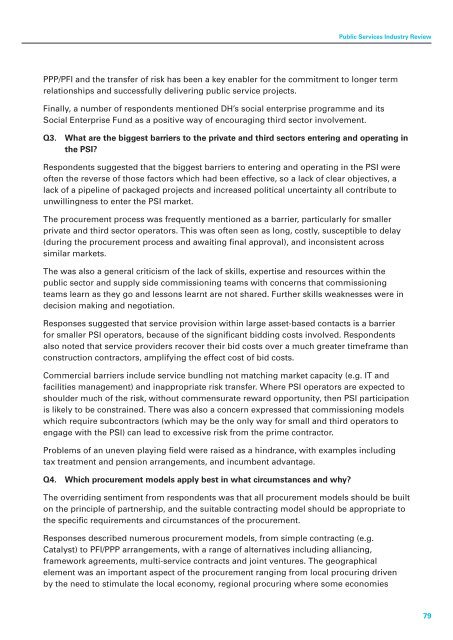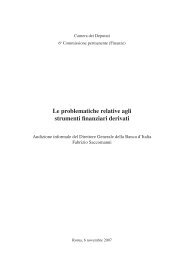Understanding the Public Services Industy
Understanding the Public Services Industy
Understanding the Public Services Industy
You also want an ePaper? Increase the reach of your titles
YUMPU automatically turns print PDFs into web optimized ePapers that Google loves.
<strong>Public</strong> <strong>Services</strong> Industry Review<br />
PPP/PFI and <strong>the</strong> transfer of risk has been a key enabler for <strong>the</strong> commitment to longer term<br />
relationships and successfully delivering public service projects.<br />
Finally, a number of respondents mentioned DH’s social enterprise programme and its<br />
Social Enterprise Fund as a positive way of encouraging third sector involvement.<br />
Q3. What are <strong>the</strong> biggest barriers to <strong>the</strong> private and third sectors entering and operating in<br />
<strong>the</strong> PSI?<br />
Respondents suggested that <strong>the</strong> biggest barriers to entering and operating in <strong>the</strong> PSI were<br />
often <strong>the</strong> reverse of those factors which had been effective, so a lack of clear objectives, a<br />
lack of a pipeline of packaged projects and increased political uncertainty all contribute to<br />
unwillingness to enter <strong>the</strong> PSI market.<br />
The procurement process was frequently mentioned as a barrier, particularly for smaller<br />
private and third sector operators. This was often seen as long, costly, susceptible to delay<br />
(during <strong>the</strong> procurement process and awaiting final approval), and inconsistent across<br />
similar markets.<br />
The was also a general criticism of <strong>the</strong> lack of skills, expertise and resources within <strong>the</strong><br />
public sector and supply side commissioning teams with concerns that commissioning<br />
teams learn as <strong>the</strong>y go and lessons learnt are not shared. Fur<strong>the</strong>r skills weaknesses were in<br />
decision making and negotiation.<br />
Responses suggested that service provision within large asset-based contacts is a barrier<br />
for smaller PSI operators, because of <strong>the</strong> significant bidding costs involved. Respondents<br />
also noted that service providers recover <strong>the</strong>ir bid costs over a much greater timeframe than<br />
construction contractors, amplifying <strong>the</strong> effect cost of bid costs.<br />
Commercial barriers include service bundling not matching market capacity (e.g. IT and<br />
facilities management) and inappropriate risk transfer. Where PSI operators are expected to<br />
shoulder much of <strong>the</strong> risk, without commensurate reward opportunity, <strong>the</strong>n PSI participation<br />
is likely to be constrained. There was also a concern expressed that commissioning models<br />
which require subcontractors (which may be <strong>the</strong> only way for small and third operators to<br />
engage with <strong>the</strong> PSI) can lead to excessive risk from <strong>the</strong> prime contractor.<br />
Problems of an uneven playing field were raised as a hindrance, with examples including<br />
tax treatment and pension arrangements, and incumbent advantage.<br />
Q4. Which procurement models apply best in what circumstances and why?<br />
The overriding sentiment from respondents was that all procurement models should be built<br />
on <strong>the</strong> principle of partnership, and <strong>the</strong> suitable contracting model should be appropriate to<br />
<strong>the</strong> specific requirements and circumstances of <strong>the</strong> procurement.<br />
Responses described numerous procurement models, from simple contracting (e.g.<br />
Catalyst) to PFI/PPP arrangements, with a range of alternatives including alliancing,<br />
framework agreements, multi-service contracts and joint ventures. The geographical<br />
element was an important aspect of <strong>the</strong> procurement ranging from local procuring driven<br />
by <strong>the</strong> need to stimulate <strong>the</strong> local economy, regional procuring where some economies<br />
79
















